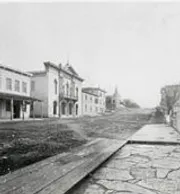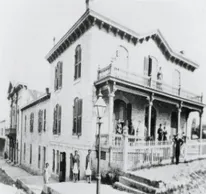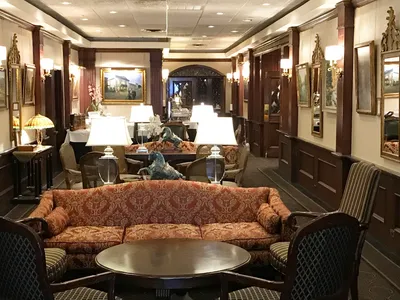Welcome to The Historic Millett
Opera House Foundation!
The Foundation is a 501(c)3.
This photograph is the only identified image of Charles F. Millett. A Master Carpenter from New York, Millett arrived in Austin in 1852, poor but skilled and rapidly became an award winning designer, builder, real estate investor, Austin’s first fire chief, City Alderman (Councilman) Districts 6 and 8, and Austin’s first true Impresario.
In 1878, at what is now 110 E. 9th Street, Charles Millett built an opera house so grand, world class Shakespearean tragedians Edwin Booth, Sir Henry Irving and Helen Modjeska, renown musicians John Philip Sousa and August Wilhelmj, actress Lily Langtry publicized as the most beautiful actress in the English speaking world, African American performing artists pianist Blind Tom and Professor Oscar Moore, the two year old savant, appeared many times. Touring companies performed the most beloved operas and plays. Gilbert and Sullivan’s Mikado and H.M. S Pinafore, Pucini’s La Boheme and Verdi’s La Traviata were performed by multiple national touring companies as well as local amateur societies.
Photo courtesy of Austin History Center, Austin Public Library

This map, a drawing by renown cartographer Augustus Koch contains the only known image of C. F. Millett Lumber, a two story building at what is now 110 E. 9th Street, which in 1878 became Millett’s Opera House. Its two foot thick limestone walls housed operations from 1859 until 1877. Inside this building, C.F. Millett’s team created and stored beautiful interior and exterior woodwork, windows, sashes, blinds, shingles, sold to a diverse group of customers including Texas Capitol and other state buildings, Austin Public Schools, and the most prosperous commercial and residential building owners.
In December 1877, Charles Millett moved his entire steam planing mill and lumber yard to a full city block he owned between West 3rd and 4th Street and San Antonio and Guadalupe Streets and began the conversion of the East 9th Street site to a nationally renown opera house.
FOR INTERACTIVE VERSION AND AUGUSTUS KOCH MAP GO TO:
https://commons.wikimedia.org/wiki/File:Old_map-Austin-1873.jpg (1873)
https://upload.wikimedia.org/wikipedia/commons/c/c9/Old_map-Austin-1887.jpg (1887) .
Photo courtesy of Austin History Center, Austin Public Library

This is the earliest known image of Millett’s Opera House. Primitive sidewalks and unpaved dirt streets suggest the photograph was taken no later than 1879 when walkways and other improvements were constructed to stop highly destructive flooding. Visitors to Millett’s Opera House wearing their finest attire, arriving by horse drawn carriage, often stepped down into this muddy street.
The first theatrical event, a popular comedy, ‘My Awful Dad’ was performed by internationally acclaimed comedic actor John Dillon on October 28th 1878 with a full company of supporting actors and the popular Max Ferhmann’s orchestra.
Photo courtesy of Austin History Center, Austin Public Library

This photograph is the only known image of the interiors of Millett’s Opera House. Designed by award winning architect Ernst Ruffini, the first version of the opera house in 1878 had second floor galleries but no boxes, eight hundred cushion chairs with arm rests in the orchestra section and a stage described by several trade journals as one of the largest in North America.
Gas powered heating and lighting but no air conditioning or fans made the house very uncomfortable from late Spring to Fall of each year. Poor sanitation systems in Austin and the stench of raw sewage in the street below made it necessary to keep opera house windows closed. The strong scent of gas fumes upset many guests.
Charles Millett was a founding member of Austin Gas and Coal Company, remained an officer and stockholder most of his life. Millett’s Opera House never had electrical power probably because electrical energy could not travel to E. 9th Street from the power plant until almost 1900.
Photo courtesy of Austin History Center, Austin Public Library

Less than a year after Millett’s Opera House opened, a boarding house owned by Charles Millett, abutting Millett’s Opera House was converted into an elegant short term lodging and dining facility. Gas street lights were installed in 1884 at the corner of East 9th and Brazos Streets where this photograph was taken.
Millett’s Mansion was never Charles Millett’s residence. Census data, deed records, voting records, city directories show that from 1873 until the time of his death in 1890, The Millett family resided in a large house at the south east corner San Jacinto and E.9th Street. U.S Marshals and their deputies were boarders of the Millett family.
Today, a modern five story parking garage exists where beautiful Millett’s Mansion, demolished 1963, once stood. A steel and glass high rise, Homer Thornberry Judicial Building stands where the family home was located.
Photo courtesy of Austin History Center, Austin Public Library

The group in the photograph are members of the International Book Binders and Printers Union. Millett’s Opera House ceased to operate as an opera house in 1897 largely due to competition from the more modern and comfortable Hancock Opera House with a larger stage, located in the first block of West 6th Street. In 1896, Charles Millett’s widow Laura Millican Millett sold Millett’s Opera House and Mansion to her brother-in-law, prominent physician Dr. M.A. Taylor, who had loaned Charles Millett $1, 000.00 in gold coin in 1870 to allow him to expand C.F. Millett Lumber. In 1897 Dr. Taylor’s son in law, attorney John Phillips Jr. purchased Millett’s Opera House, made significant changes including adding a third floor for a family residence, altered the shape and size of the second story windows and converted the building to multiple uses for small meeting rooms, warehouse space for personal effects, book binding and sales exhibits. Printing companies including Austin American Statesman and stationary stores occupied the first floor of Millett’s Opera House for many decades after the 1897 sale.
Photo courtesy of Austin History Center, Austin Public Library

The group in the photograph are members of VON BOECKMANN – JONES CO., a printing company which purchased Millett’s Opera House from Capitol Knights of Columbus in June of 1929.
From 1910 when John Phillips sold Millett’s Opera House to Capitol Knights of Columbus until its sale to VON BOECKMANN JONES in June of 1929, Capitol Knights of Columbus was reported by Austin American Statesman to have spent more remodeling the Millett Opera House than any remodeling project of its kind in the history of Austin. Changes to the exterior facades by Capitol Knights of Columbus included creating a second story veranda with two story columns, altering the appearance to a Greek Revival style, more like the Texas Governor’s Mansion. No picture of the building while owned by Capitol Knights of Columbus has been identified.
Photo courtesy of Austin History Center, Austin Public Library

VON BOECKMANN-JONES sold Millett’s Opera House to Austin Public Schools in 1940 but continued to occupy it for another ten years before moving to other spaces. Tenants came and went leaving Millett’s Opera House in a serious state of decay, threatened with demolition. In 1955, Maverick-Clarke Litho, a successful San Antonio printing company, leased the building, constructed showcase windows and installed elaborate decorative wrought iron on the front exterior facades in an effort to recreate the distinctive original design existing at street level before Capitol Knights of Columbus altered its design in 1911. From 1955 to about 1975, Millett’s Opera House was celebrated as an example of successful contemporary commercial use of a historic urban building. In 1965, Millett’s Opera House became a recorded Texas historic landmark.
Photo courtesy of Austin History Center, Austin Public Library

Acclaimed muralist Richard Anderson, retained in 1991 by The Austin Club, spent three years creating life size murals of the artists who performed on the Millett’s Opera House stage. Anderson exhaustively researched the actual performances at Millett’s Opera House, as well as the actors’ sometimes notorious behaviors, before creating the murals. Beginning with the east wall of the dining room, the actors and scenes depicted are: Comedian J.K. Emmet and “Plimlimmon, the largest most handsome dog in the world”, Lily Langtry, reputedly the most beautiful actress in the English speaking world in A Wife’s Peril, The Leg Girls, actually quite chaste Burlesque actresses considered “simply shocking” in their day, a collage of renown Shakespearean tragedians Edwin Booth and Helen Modjeska in Julius Caesar, Sir Henry Irving and Dame Ellen Terry in King Lear, The Mikado and H.M. S. Pinafore performed by local amateur acting societies, William Jennings Bryan on a private speaking tour, Robin Hood and His Band of Merry Men, The Count of Monte Christo and The Merchant of Venice. Diners in the Austin Mural Room often remarks that it is as if these performers have joined them for lunch or dinner.
Photo courtesy of Austin History Center, Austin Public Library

Millett’s Opera House is now a Museum as well as a historic opera house and proudly exhibits hundreds of valuable works of art including paintings, sculpture, theatrical items and period furnishings, professionally curated and exhibited. Many valuable art works have been donated or loaned by The Austin Club members.
Millet’s Opera House Foundation is a proud sponsor of and host site for several internship programs. Graduate history and fine arts students, museum and historic house employees work at Millett’s Opera House Museum researching, archiving, curating and exhibiting and as well providing art on loan to Millett’s Opera House from their museums and historic houses.
Photo courtesy of Austin History Center, Austin Public Library
